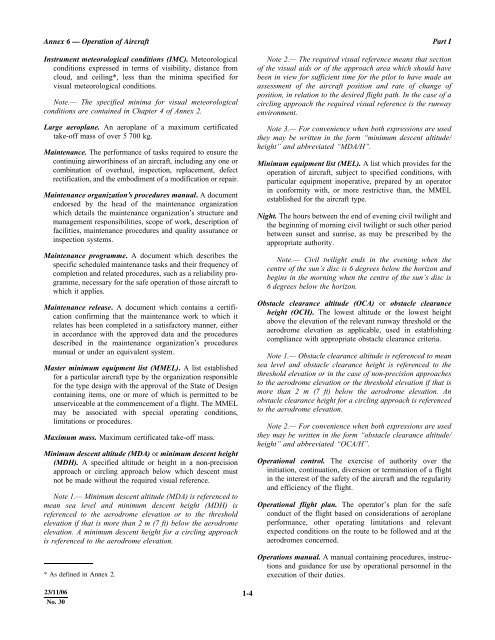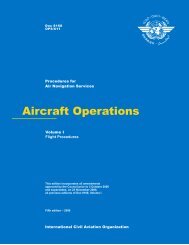Operation of Aircraft
Annex 6, Part I
Annex 6, Part I
- No tags were found...
You also want an ePaper? Increase the reach of your titles
YUMPU automatically turns print PDFs into web optimized ePapers that Google loves.
Annex 6 — <strong>Operation</strong> <strong>of</strong> <strong>Aircraft</strong><br />
Instrument meteorological conditions (IMC). Meteorological<br />
conditions expressed in terms <strong>of</strong> visibility, distance from<br />
cloud, and ceiling*, less than the minima specified for<br />
visual meteorological conditions.<br />
Note.— The specified minima for visual meteorological<br />
conditions are contained in Chapter 4 <strong>of</strong> Annex 2.<br />
Large aeroplane. An aeroplane <strong>of</strong> a maximum certificated<br />
take-<strong>of</strong>f mass <strong>of</strong> over 5 700 kg.<br />
Maintenance. The performance <strong>of</strong> tasks required to ensure the<br />
continuing airworthiness <strong>of</strong> an aircraft, including any one or<br />
combination <strong>of</strong> overhaul, inspection, replacement, defect<br />
rectification, and the embodiment <strong>of</strong> a modification or repair.<br />
Maintenance organization’s procedures manual. A document<br />
endorsed by the head <strong>of</strong> the maintenance organization<br />
which details the maintenance organization’s structure and<br />
management responsibilities, scope <strong>of</strong> work, description <strong>of</strong><br />
facilities, maintenance procedures and quality assurance or<br />
inspection systems.<br />
Maintenance programme. A document which describes the<br />
specific scheduled maintenance tasks and their frequency <strong>of</strong><br />
completion and related procedures, such as a reliability programme,<br />
necessary for the safe operation <strong>of</strong> those aircraft to<br />
which it applies.<br />
Maintenance release. A document which contains a certification<br />
confirming that the maintenance work to which it<br />
relates has been completed in a satisfactory manner, either<br />
in accordance with the approved data and the procedures<br />
described in the maintenance organization’s procedures<br />
manual or under an equivalent system.<br />
Master minimum equipment list (MMEL). A list established<br />
for a particular aircraft type by the organization responsible<br />
for the type design with the approval <strong>of</strong> the State <strong>of</strong> Design<br />
containing items, one or more <strong>of</strong> which is permitted to be<br />
unserviceable at the commencement <strong>of</strong> a flight. The MMEL<br />
may be associated with special operating conditions,<br />
limitations or procedures.<br />
Maximum mass. Maximum certificated take-<strong>of</strong>f mass.<br />
Minimum descent altitude (MDA) or minimum descent height<br />
(MDH). A specified altitude or height in a non-precision<br />
approach or circling approach below which descent must<br />
not be made without the required visual reference.<br />
Note 1.— Minimum descent altitude (MDA) is referenced to<br />
mean sea level and minimum descent height (MDH) is<br />
referenced to the aerodrome elevation or to the threshold<br />
elevation if that is more than 2 m (7 ft) below the aerodrome<br />
elevation. A minimum descent height for a circling approach<br />
is referenced to the aerodrome elevation.<br />
* As defined in Annex 2.<br />
Part I<br />
Note 2.— The required visual reference means that section<br />
<strong>of</strong> the visual aids or <strong>of</strong> the approach area which should have<br />
been in view for sufficient time for the pilot to have made an<br />
assessment <strong>of</strong> the aircraft position and rate <strong>of</strong> change <strong>of</strong><br />
position, in relation to the desired flight path. In the case <strong>of</strong> a<br />
circling approach the required visual reference is the runway<br />
environment.<br />
Note 3.— For convenience when both expressions are used<br />
they may be written in the form “minimum descent altitude/<br />
height” and abbreviated “MDA/H”.<br />
Minimum equipment list (MEL). A list which provides for the<br />
operation <strong>of</strong> aircraft, subject to specified conditions, with<br />
particular equipment inoperative, prepared by an operator<br />
in conformity with, or more restrictive than, the MMEL<br />
established for the aircraft type.<br />
Night. The hours between the end <strong>of</strong> evening civil twilight and<br />
the beginning <strong>of</strong> morning civil twilight or such other period<br />
between sunset and sunrise, as may be prescribed by the<br />
appropriate authority.<br />
Note.— Civil twilight ends in the evening when the<br />
centre <strong>of</strong> the sun’s disc is 6 degrees below the horizon and<br />
begins in the morning when the centre <strong>of</strong> the sun’s disc is<br />
6 degrees below the horizon.<br />
Obstacle clearance altitude (OCA) or obstacle clearance<br />
height (OCH). The lowest altitude or the lowest height<br />
above the elevation <strong>of</strong> the relevant runway threshold or the<br />
aerodrome elevation as applicable, used in establishing<br />
compliance with appropriate obstacle clearance criteria.<br />
Note 1.— Obstacle clearance altitude is referenced to mean<br />
sea level and obstacle clearance height is referenced to the<br />
threshold elevation or in the case <strong>of</strong> non-precision approaches<br />
to the aerodrome elevation or the threshold elevation if that is<br />
more than 2 m (7 ft) below the aerodrome elevation. An<br />
obstacle clearance height for a circling approach is referenced<br />
to the aerodrome elevation.<br />
Note 2.— For convenience when both expressions are used<br />
they may be written in the form “obstacle clearance altitude/<br />
height” and abbreviated “OCA/H”.<br />
<strong>Operation</strong>al control. The exercise <strong>of</strong> authority over the<br />
initiation, continuation, diversion or termination <strong>of</strong> a flight<br />
in the interest <strong>of</strong> the safety <strong>of</strong> the aircraft and the regularity<br />
and efficiency <strong>of</strong> the flight.<br />
<strong>Operation</strong>al flight plan. The operator’s plan for the safe<br />
conduct <strong>of</strong> the flight based on considerations <strong>of</strong> aeroplane<br />
performance, other operating limitations and relevant<br />
expected conditions on the route to be followed and at the<br />
aerodromes concerned.<br />
<strong>Operation</strong>s manual. A manual containing procedures, instructions<br />
and guidance for use by operational personnel in the<br />
execution <strong>of</strong> their duties.<br />
1/11/01 23/11/06<br />
1-4<br />
No. 30












